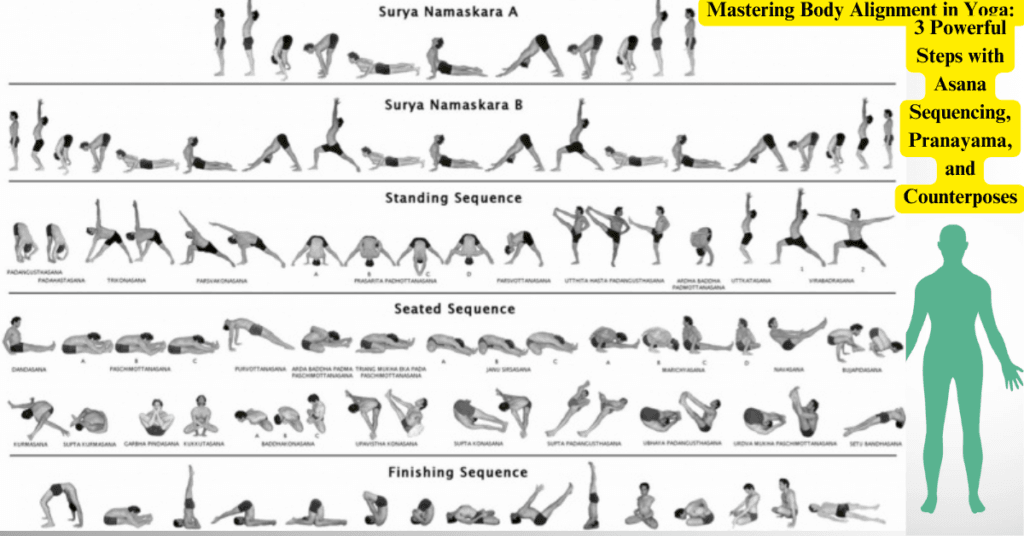
Table of Contents
Mastering Body Alignment in Yoga: 3 Powerful Steps with Asana Sequencing, Pranayama, and Counterposes
Body Alignment in Yoga : Yoga offers a significant method for interfacing the psyche, body, and soul. Nonetheless, without legitimate arrangement, both the security and adequacy of the training can be compromised. Body arrangement is the way to performing yoga stances (asanas) in a way that keeps up with underlying honesty, expands energy stream, and lessens the gamble of injury. Adjusting the body accurately guarantees that every development fills its expected need, encouraging adaptability, strength, and equilibrium.
In this article, we investigate the three fundamental components for dominating body arrangement in Body Alignment in Yoga: Asana Sequencing, Pranayama (breathwork), and Counterposes. Whether you are a novice or a high level professional, these means offer a total structure to construct an economical and satisfying yoga practice.

1. Asana Sequencing : Making a Reasonable Stream
What is Asana Sequencing?
Asana sequencing alludes to organizing yoga stances in a purposeful and legitimate request to guarantee a smooth change between presents, appropriate muscle commitment, and generally Body Alignment in Yoga. A painstakingly planned grouping readies the body to extend securely into complex postures while forestalling injury. Each part of the succession fills an unmistakable need — warm-up presents, center reinforcing asanas, adjusting stances, and chilling off extends add to an all encompassing encounter.
Design of a Compelling Asana Grouping
Warm-Up Stances
Model: Feline Cow (Marjaryasana-Bitilasana)
Heats up the spine and increments adaptability in the neck, shoulders, and back.
Model: Descending Confronting Canine (Adho Mukha Svanasana)
Enacts the whole body and sets it up for more profound stretches.
Standing Postures
Model: Hero I and II (Virabhadrasana I and II)
Reinforce the legs, draw in the center, and improve strength.
Model: Tree Posture (Vrikshasana)
Advances balance and adjusts the spine by connecting with center muscles.
Center Work and Backbends
Model: Boat Posture (Navasana)
Reinforces the stomach muscles, upgrading spinal arrangement.
Model: Cobra Posture (Bhujangasana)
Opens the chest and neutralizes slumping, adjusting stance.
Cool-Down and Helpful Postures
Model: Kid’s Posture (Balasana)
Loosens up the spine and deliveries pressure from the back and hips.
Model: Cadaver Posture (Savasana)
Carries the body and psyche to a condition of rest, incorporating the advantages of the training.
Significance of Appropriate Sequencing
A very much organized grouping guarantees that muscles are warmed, extended, and reinforced logically. This technique limits strain and fabricates perseverance after some time, adjusting the body normally as it travels through various stances. Appropriate sequencing additionally assists experts with entering testing presents with strength, guaranteeing they keep away from injury or overexertion.
2. Pranayama: Outfitting Breath for Arrangement
What is Pranayama?
Pranayama is the act of controlling the breath, a fundamental piece of yoga that interfaces body and psyche. “Prana” alludes to life force, and “ayama” signifies expansion or control. It guarantees that the breath directs the body’s development, permitting professionals to hold stances In yoga, breathwork is basic for keeping up with mindfulness and solidness in each stance.effortlessly.
Pranayama Strategies to Further develop Body Arrangement
Ujjayi Breath (Triumphant Breath):
Includes slow, full breaths through the nose with a slight tightening in the throat.
Manages breathing during testing asanas and advances center.
Nadi Shodhana (Substitute Nostril Relaxing):
Balances energy stream between the left and right sides of the body.
Makes mental lucidity and upgrades the coordination in adjusting stances.
Kapalabhati (Purging Breath) : Includes quick, intense exhalations followed by uninvolved inward breaths.
Reinforces the center and stomach, which works on postural arrangement.
Breath-Body Arrangement Association
Every asana in yoga is upgraded when it is synchronized with the breath. For instance:
Breathe out during forward folds to deliver the hamstrings and loosen up the spine.
Breathe in while lifting the chest or extending the ribcage in backbends like Cobra Posture.
By zeroing in on breath control, specialists can keep away from shallow breathing that prompts firmness and misalignment. deep breathing draws in the center and adjusts the spine normally, making changes smoother and more steady.
3. Counterposes for Body Alignment in Yoga: Reestablishing harmony and Forestalling Injury
What are Counterposes?
A counterpose is a stance that kills or balances the impacts of a past asana. Since every yoga pose stretches or contracts explicit muscles, it is vital to follow serious postures with correlative developments to keep up with balance in the body. Counterposes are fundamental in delivering pressure and reestablishing arrangement in regions that were locked in during the primary asanas.
Normal Counterpose Models for Body Alignment in Yoga :
Youngster’s Posture (Balasana) after backbends like Camel Posture (Ustrasana).
Assists the spine with getting back to an unbiased position.
Situated Ahead Overlay (Paschimottanasana) subsequent to standing postures like Fighter III (Virabhadrasana III).
Delicately extends the hamstrings and loosens up the lower back.
Prostrate Contort (Supta Matsyendrasana) after Extension Posture (Setu Bandhasana).
Discharges spinal pressure and realigns the vertebrae.
Meaning of Counterposes in Body Alignment in Yoga
Without counterposes, muscles might stay tight or overwhelmed, prompting uneasiness or misalignment. Consolidating these adjusting developments guarantees the body recalibrates and gets back to a condition of harmony. Counterposes likewise forestall wounds by alleviating tension on joints and ligaments prior to changing to different exercises or shutting the training.
Step by step instructions to Coordinate Asana Sequencing, Pranayama, and Counterposes
At the point when rehearsed together, these three components make a far reaching yoga experience. Every part upholds the other, guaranteeing that the training is protected, successful, and charming.
This is the way they meet up in a commonplace yoga meeting:
Start with a Warm-Up Grouping:
Perform Sun Welcome (Surya Namaskar) with Ujjayi breath to heat up the body and adjust the spine.
Move through Asanas with Pranayama:
Draw in the center and synchronize developments with the breath to keep up with equilibrium and concentration. For instance, use Nadi Shodhana prior to entering adjusting presents like Tree Posture.
End with Counterposes:
In the wake of testing backbends or standing postures, change to advance overlap and turns to reestablish arrangement and quiet the sensory system.
Close with Supportive Postures:
Use Savasana and careful breathing to coordinate the advantages of the training.
End
Dominating Body Alignment in Yoga expects tender loving care and a careful methodology. By zeroing in on asana sequencing, pranayama, and counterposes, professionals can make a protected, adjusted, and improving practice that sustains both physical and mental prosperity. Appropriate sequencing takes into account continuous advancement, pranayama interfaces development with breath, and counterposes guarantee recuperation and forestall injury.
This three-step approach establishes the groundwork for a comprehensive yoga venture — one where the body, breath, and brain move together as one. With predictable practice, you’ll refine your arrangement as well as open further degrees of mindfulness, adaptability, and internal harmony.
Thus, step onto your mat, inhale profoundly, adjust purposefully, and experience the groundbreaking force of yoga.


